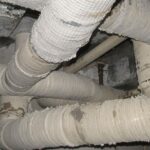Historical Use of Asbestos in HVAC Systems
Asbestos was widely used in heating, ventilation, and air conditioning (HVAC) systems from the early 20th century until its regulation in the late 1970s. Manufacturers favored asbestos for its fire-resistant properties, durability, and insulating capabilities. It was commonly found in ductwork, insulation, and adhesives, making it a staple material for HVAC components during that era.
Common Locations of Asbestos in HVAC Components
Asbestos can be hidden in several areas of older HVAC systems. Some typical spots include:
- Ductwork connectors: These were often wrapped in asbestos tape to seal air leaks.
- Insulation materials: Asbestos was used to insulate pipes, furnaces, and boilers.
- Adhesives and sealants: Many HVAC systems relied on asbestos-based products to bind and seal components.
If your home was built before the 1980s, it’s wise to assume asbestos might be present in your HVAC system and consult a professional for testing.
Why Asbestos Was Used in HVAC Systems
The primary reason asbestos became so prevalent in HVAC systems was its exceptional heat resistance. It could withstand high temperatures without degrading, which made it ideal for insulating and protecting heating and cooling systems. Additionally, asbestos was cost-effective and easy to work with, further cementing its place in HVAC manufacturing. However, the health risks associated with airborne asbestos fibers far outweigh its benefits, leading to its eventual phase-out and regulation.
Health Risks Associated with Asbestos in HVAC Systems
How Asbestos Fibers Affect Human Health
Asbestos fibers are incredibly tiny, almost invisible to the naked eye, but their impact on human health can be devastating. When disturbed, these fibers become airborne and can be inhaled or swallowed. Once inside the body, they embed themselves in tissues, causing inflammation and scarring. This process can lead to severe health conditions over time. The body cannot break down or expel asbestos fibers, meaning they remain a constant source of irritation, potentially leading to long-term damage.
Diseases Linked to Asbestos Exposure
Exposure to asbestos is directly linked to several serious diseases, including:
- Mesothelioma: A rare and aggressive cancer that affects the lining of the lungs, abdomen, or heart.
- Asbestosis: A chronic lung disease caused by scarring of lung tissue, which leads to difficulty breathing.
- Lung Cancer: Prolonged asbestos exposure significantly increases the risk of developing lung cancer.
- Other cancers: Asbestos exposure has also been linked to cancers of the larynx and ovaries.
Even short-term exposure to asbestos can increase the risk of developing these illnesses, emphasizing the need for caution.
Symptoms of Asbestos-Related Illnesses
The symptoms of asbestos-related diseases often take decades to appear, making early detection challenging. Common symptoms include:
- Persistent, dry cough
- Shortness of breath, even with minimal exertion
- Chest or abdominal pain
- Unexplained weight loss
- Fatigue and general weakness
These symptoms can easily be mistaken for other conditions, so it’s essential to inform your doctor about any past asbestos exposure. Early diagnosis can improve treatment outcomes.
For instance, asbestos fibers released during renovations can pose a significant health risk, underscoring the importance of proper testing and management. Awareness of these risks is vital for both homeowners and professionals to ensure safety.
Identifying Asbestos in Your Heating and Cooling Systems
Signs of Asbestos in HVAC Systems
Determining whether your HVAC system contains asbestos can be tricky, especially since it’s not always visible to the untrained eye. One key indicator is the age of your system—if it was installed before the mid-1980s, there’s a higher chance asbestos might be present. Look for white, papery material or deteriorating wraps around ductwork, vents, or pipes. These are common signs of asbestos-containing materials.
Common areas to check include:
- Ductwork connectors
- Heat vents
- Furnace components
- Air conditioning units
If you notice anything suspicious, avoid touching or disturbing the material as this can release harmful fibers into the air.
Testing for Asbestos in HVAC Components
Testing is the only way to confirm the presence of asbestos. Since asbestos fibers are microscopic, a professional lab analysis is required. Homeowners should never attempt to collect samples themselves, as improper handling can lead to contamination. Instead, hire a certified asbestos inspector who will:
- Conduct a visual inspection of your HVAC system.
- Safely collect samples from suspect areas.
- Provide a detailed report on whether asbestos is present and its condition.
Testing is especially important if you plan to renovate or repair your HVAC system.
When to Call a Professional for Asbestos Inspection
If you suspect asbestos in your HVAC system, it’s best to consult a licensed professional. They have the tools and expertise to safely identify and handle asbestos without risking exposure. Situations that warrant calling a professional include:
- Visible damage to insulation or ductwork.
- Planning major repairs or upgrades to your HVAC system.
- Noticing debris or dust around heating and cooling components.
Remember, asbestos is only dangerous when it’s disturbed and becomes airborne. Taking a proactive approach with professional help can protect your family’s health and ensure your HVAC system is safe to use.
Common Asbestos-Containing Materials in HVAC Systems
Asbestos Insulation and Wraps
Asbestos was often used in insulation and wraps for HVAC systems. These materials were applied to boilers, ducts, and pipes to prevent heat loss and condensation. Insulation made from asbestos typically contained about 15% chrysotile, a common type of asbestos. Over time, this insulation can deteriorate, releasing harmful fibers into the air.
Adhesives and Sealants with Asbestos
Adhesives and sealants containing asbestos were commonly used to secure HVAC components. For instance, asbestos tape was wrapped around duct connectors to create a strong seal. These adhesives were also applied at pipe joints or where ducts connected to walls. While effective at the time, these materials can degrade, posing significant health risks if disturbed.
Asbestos in Ductwork and Connectors
Many older HVAC systems included ductwork and connectors made with asbestos-containing materials. Items like vibration dampeners, which reduced noise in duct systems, were often manufactured with asbestos cloth. Similarly, duct connectors sometimes incorporated asbestos to ensure airtight seals. If these components become damaged or worn, they can release asbestos fibers into the air, creating a hazardous environment.
The Dangers of Disturbed Asbestos in HVAC Systems
How Asbestos Becomes Airborne
When asbestos in HVAC systems is disturbed, whether through maintenance, aging, or damage, its fibers can break apart and become airborne. These fibers are microscopic and invisible to the naked eye, making them particularly insidious. HVAC systems that circulate air can easily spread these fibers throughout a building, increasing the risk of exposure. No level of asbestos exposure is considered safe, which underscores the importance of handling it with care.
Risks of DIY Asbestos Removal
Attempting to remove asbestos-containing materials without professional help can be incredibly dangerous. Disturbing asbestos insulation, old duct tape, or other components releases fibers into the air, putting everyone in the vicinity at risk. Key risks of DIY asbestos removal include:
- Inhalation of airborne fibers, which can lead to long-term health issues.
- Improper disposal, which may violate local regulations.
- Contaminating other parts of the home through improper handling.
If asbestos is suspected in an HVAC system, it’s always wiser to call licensed professionals.
Preventing Asbestos Exposure During HVAC Maintenance
Preventing exposure starts with awareness. Before performing any maintenance on an older HVAC system, homeowners and workers should:
- Identify materials that may contain asbestos, such as insulation wraps or duct connectors.
- Avoid disturbing any suspected asbestos-containing materials.
- Hire a certified asbestos professional to inspect and, if necessary, safely remove hazardous materials.
Taking these precautions can significantly reduce the risks associated with asbestos in HVAC systems.
Regulations and Guidelines for Asbestos in HVAC Systems
EPA Regulations on Asbestos Use
The U.S. Environmental Protection Agency (EPA) has been at the forefront of regulating asbestos use since the late 1970s. The Clean Air Act mandates strict guidelines to minimize asbestos exposure, especially in residential and commercial HVAC systems. These regulations prohibit the use of asbestos in new HVAC components and outline procedures for the safe removal and disposal of existing asbestos-containing materials. Homeowners should be aware that while asbestos use is heavily restricted, it has not been entirely banned in the U.S. The Asbestos Program, enforced by the EPA, plays a critical role in safeguarding public health by ensuring compliance with these standards.
Safe Handling and Disposal of Asbestos
Handling asbestos requires specialized knowledge and equipment. It’s vital to follow safety protocols to prevent asbestos fibers from becoming airborne. This includes sealing off affected areas, using protective gear, and employing HEPA filters during cleanup. Disposal must adhere to local, state, and federal guidelines, which often mandate the use of approved facilities for asbestos waste. Never attempt to remove asbestos-containing materials on your own; instead, hire a licensed abatement professional to ensure safety.
Legal Implications of Asbestos in Homes
Owning a property with asbestos can have legal and financial ramifications. Homeowners may be held liable if asbestos exposure occurs due to negligence, such as improper maintenance or unauthorized removal. Additionally, selling a home with known asbestos issues often requires full disclosure to potential buyers. Failure to comply with asbestos regulations can result in fines or lawsuits. Understanding your legal responsibilities can help you avoid complications and protect your family and community.
Protecting Your Family from Asbestos in HVAC Systems
Steps to Minimize Asbestos Exposure
To keep your family safe from asbestos exposure, it’s essential to take a cautious and proactive approach. Avoid disturbing any materials that might contain asbestos, as this can release harmful fibers into the air. Here’s what you can do:
- Do not attempt to clean, repair, or remove any HVAC components suspected of containing asbestos on your own.
- If you notice any damage to insulation, ductwork, or other materials, isolate the area and restrict access.
- Always assume that older HVAC systems might have asbestos, especially if they were installed before the 1980s, and consult a professional for an inspection.
When to Turn Off Your HVAC System
If you suspect asbestos contamination, turning off your HVAC system can help prevent the spread of fibers through your home. Here’s when you should consider shutting it down:
- If you see visible damage to HVAC components, such as torn insulation or deteriorating duct tape.
- When you suspect asbestos has been disturbed during renovations or repairs.
- If a professional advises you to do so after an initial inspection.
By shutting off the system, you can reduce the risk of airborne asbestos circulating in your living spaces.
Hiring Licensed Asbestos Professionals
Dealing with asbestos requires expertise and proper equipment. Licensed asbestos professionals are trained to handle and dispose of asbestos safely. When hiring a contractor:
- Verify their certification and experience in asbestos abatement.
- Ensure they follow safety protocols to prevent the spread of asbestos dust.
- Confirm that they use protective gear, such as masks and eye protection, during the process.
Taking these steps ensures your family’s safety and compliance with regulations. For more information, ensure contractors adhere to safety regulations and guidelines during asbestos removal.
Occupational Risks of Asbestos Exposure in HVAC Work
HVAC Mechanics and Asbestos Exposure
HVAC mechanics face some of the highest risks of asbestos exposure. Their work often involves repairing and maintaining older systems, many of which contain asbestos in insulation, ductwork, and other components. When asbestos-containing materials are disturbed—cut, sanded, or broken—fibers can become airborne, posing a serious health risk. Tasks like changing filters, opening panels, or repairing ducts can unknowingly release these fibers into the air. Workers in buildings constructed before the 1980s are particularly at risk, as asbestos was widely used in construction materials during that time.
High-Risk Occupations for Asbestos-Related Diseases
While HVAC workers are at significant risk, they are not alone. Other professions frequently exposed to asbestos include:
- Construction workers
- Pipefitters and plumbers
- Insulation installers
- Demolition contractors
- Steelworkers
Even family members of these workers can face secondary exposure when asbestos fibers are brought home on clothing or equipment. This indirect exposure can still lead to severe health complications over time.
Safety Protocols for HVAC Workers
To reduce the risks associated with asbestos, strict safety measures should always be followed. These include:
- Wearing protective gear, such as respirators and disposable coveralls.
- Avoiding any direct handling of materials suspected to contain asbestos without proper training.
- Using wet methods to minimize dust when working on older HVAC systems.
- Seeking professional asbestos abatement services for high-risk tasks.
By adhering to these protocols, HVAC workers can significantly lower their chances of asbestos exposure, safeguarding both their health and the well-being of those around them.
Preventing Asbestos Exposure in Older HVAC Systems
Identifying High-Risk HVAC Systems
Older HVAC systems, especially those installed before the 1980s, are more likely to contain asbestos. Key components to inspect include ductwork, insulation, and connectors. Always treat materials in these systems as potentially hazardous until confirmed otherwise. Common asbestos-containing materials include duct wraps, adhesives, and insulation. If you notice white, papery material or signs of deterioration, it’s a red flag that warrants professional inspection.
Modern Alternatives to Asbestos Materials
Thankfully, modern HVAC systems use safer, asbestos-free materials. Options like fiberglass insulation, coated fabric dampeners, and non-toxic adhesives have replaced asbestos in most applications. If you’re upgrading your system, consider these alternatives to reduce long-term risks. Retrofitting older systems with modern components is another way to enhance safety and efficiency.
Routine Maintenance to Reduce Risks
Regular upkeep of your HVAC system helps minimize the chances of asbestos exposure. Follow these steps:
- Schedule annual professional inspections, especially for older systems.
- Replace damaged or worn components promptly with asbestos-free alternatives.
- Avoid DIY repairs or cleaning if asbestos is suspected—disturbing materials can release fibers into the air.
If you’re performing winter maintenance tasks like replacing filters or servicing your system, take extra precautions to avoid disturbing any potentially hazardous materials. A proactive approach can go a long way in keeping your home safe.
The Role of Asbestos in HVAC System Failures
How Asbestos Deteriorates Over Time
Asbestos materials in HVAC systems, once considered durable and fire-resistant, degrade with age. Over time, exposure to moisture, heat, and air movement can cause these materials to crumble or break apart. This deterioration increases the likelihood of asbestos fibers becoming airborne, posing a health risk. For instance, asbestos tape used on ductwork connectors often becomes brittle and flakes off, releasing microscopic fibers into the air. These fibers are not only dangerous to inhale but can also lead to reduced structural integrity in the HVAC components themselves.
Impact on HVAC System Efficiency
When asbestos-containing materials start to break down, they can obstruct airflow or damage essential parts of the HVAC system. For example, deteriorating asbestos insulation can clog vents or filters, forcing the system to work harder to maintain temperatures. This added strain often results in higher energy bills and frequent breakdowns. Additionally, the presence of asbestos fibers in the system can lead to contamination of air ducts, reducing the overall air quality in the building.
Costs of Repairing Asbestos-Contaminated Systems
Repairing an HVAC system contaminated with asbestos is not only complex but also expensive. Homeowners must hire licensed professionals for safe removal and disposal of asbestos materials, as improper handling can exacerbate the problem. The costs typically include:
- Testing to confirm the presence of asbestos.
- Specialized removal and disposal services.
- Replacement of contaminated components, such as ductwork or insulation.
Ignoring the issue can lead to even higher costs, as prolonged exposure to asbestos may necessitate a complete system overhaul or, worse, result in health-related expenses. Visible signs like crumbling asbestos tiles or frayed pipe wraps should prompt immediate action to mitigate risks.
Legal and Financial Aspects of Asbestos in HVAC Systems
Compensation for Asbestos-Related Illnesses
When someone is diagnosed with an asbestos-related illness, like mesothelioma or asbestosis, they may be eligible for financial compensation. This can include coverage for medical expenses, lost wages, and even emotional damages. Victims often file lawsuits against manufacturers that knowingly used asbestos in their products. Holding these companies accountable has helped many individuals and families manage the financial burden of these illnesses.
Insurance Coverage for Asbestos Removal
Homeowners insurance policies typically do not cover asbestos removal unless the asbestos is disturbed due to a covered peril, like a fire or storm. However, some specialized policies or riders may include asbestos abatement. It’s important to review your insurance policy carefully and speak with your provider to understand what’s covered. If asbestos removal is necessary, homeowners should be prepared for potentially high costs.
Legal Responsibilities of Homeowners
Homeowners have a legal duty to disclose the presence of asbestos when selling their property. Failure to do so may result in lawsuits or fines. Additionally, any removal or remediation of asbestos must comply with local and federal regulations. Homeowners should hire licensed professionals to ensure that all work is done safely and legally. Mishandling asbestos-containing materials can elevate exposure risks, and following safe handling and disposal guidelines is essential for protecting everyone involved.
Future Trends in Asbestos-Free HVAC Systems
Innovations in HVAC Materials
The HVAC industry is moving toward safer and more sustainable materials to replace asbestos. These innovations are not just about safety; they also focus on efficiency and environmental impact. For example, modern insulation materials like aerogels and fiberglass are becoming popular because they are non-toxic and highly efficient at thermal regulation. These materials ensure the safety of both installers and homeowners while maintaining optimal system performance.
Government Initiatives to Eliminate Asbestos
Governments worldwide are introducing stricter guidelines to phase out asbestos entirely. In the U.S., for instance, the Environmental Protection Agency (EPA) has pushed for more stringent regulations on asbestos use and disposal. Countries are also offering incentives for homeowners to upgrade their old HVAC systems to modern, asbestos-free alternatives. This includes rebates for switching to electric heat pumps, which are not only asbestos-free but also eco-friendly. Learn more about converting to electric heat pumps.
Consumer Awareness and Demand for Safer Systems
As consumers become more informed about the dangers of asbestos, there is a growing demand for HVAC systems that prioritize health and safety. Manufacturers are responding by marketing products explicitly labeled as asbestos-free. This shift is also driven by homebuyers who now see asbestos-free systems as a key selling point for properties. Additionally, optimizing HVAC systems for energy efficiency, such as through smart installations, aligns with modern safety and sustainability standards. Find out how smart HVAC installations can save energy.





